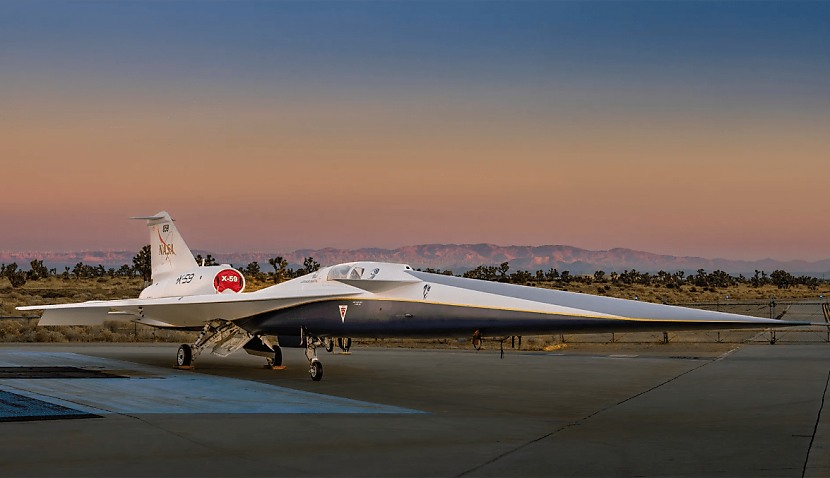
The technological advancements created by the X-59 are hugely significant, given that non-military aircraft are banned from flying faster than the speed of sound over land – a rule that contributed to the early retirement of the Concorde.
The aircraft can reduce the sonic boom to a quieter “thump” – compared to slamming a car door – because its tapered nose breaks up the shock waves traditionally created when an aircraft surpasses the sound barrier.
NASA’s deputy administrator, Pam Melroy, called the X-59 Quesst, created in collaboration with Lockheed Martin, a “major accomplishment”.
“In just a few short years, we’ve gone from an ambitious concept to reality,” she said.
“NASA’s X-59 will help change the way we travel, bringing us closer together in much less time.”
The aircraft was unveiled at Lockheed’s secretive Skunk Works facility in the Mojave desert in California.
“At 99.7 feet long and 29.5 feet wide, the aircraft’s shape and the technological advancements it houses will make quiet supersonic flight possible,” said NASA.
“The X-59’s thin, tapered nose accounts for almost a third of its length and will break up the shock waves that would ordinarily result in a supersonic aircraft causing a sonic boom.
“Due to this configuration, the cockpit is located almost halfway down the length of the aircraft – and does not have a forward-facing window.
“Instead, the Quesst team developed the eXternal Vision System, a series of high-resolution cameras feeding a 4K monitor in the cockpit.
“The Quesst team also designed the aircraft with its engine mounted on top and gave it a smooth underside to help keep shockwaves from merging behind the aircraft and causing a sonic boom.”
The aircraft will take off for the first time later this year, before attempting its first quiet supersonic flight.
The test flights will occur at Skunk Works before transferring to NASA’s Armstrong Flight Research Center in Edwards, California, which will serve as its base of operations.
Afterwards, the aircraft will be flown over selected cities in the US to test out the effects of the quieter sonic thump on residents, taking in their feedback.
“The X-59 is a unique experimental airplane, not a prototype – its technologies are meant to inform future generations of quiet supersonic aircraft,” said NASA.
While the current aircraft can only seat one person, it’s hoped the design principles will lead to the creation of larger, commercial passenger airliners as soon as 2035.
Peter Coen, NASA’s Quesst mission integration manager, told journalists, “We’re definitely ready to write a new chapter in the history of supersonic flight, making air travel over land twice as fast but in a way that is safe, sustainable and so much quieter than before.”
Friday’s unveiling, which you can watch on NASA’s YouTube channel, was the first time the aircraft was seen in its final red, white, and blue livery.
NASA awarded Lockheed Martin’s Skunk Works a US$247.5 million contract to design, build, and fly a 30-metre demonstrator prototype – X-59 QuessT – but its progress has been slower than hoped.
Space Connect last reported on its development back in 2011, when NASA released a time lapse video showing the X-59’s wing, tail, and fuselage being merged together.
In the years since, very little information on it has been released, though NASA did release a further video last year charting its progress.

Adam Thorn
Adam is a journalist who has worked for more than 40 prestigious media brands in the UK and Australia. Since 2005, his varied career has included stints as a reporter, copy editor, feature writer and editor for publications as diverse as Fleet Street newspaper The Sunday Times, fashion bible Jones, media and marketing website Mumbrella as well as lifestyle magazines such as GQ, Woman’s Weekly, Men’s Health and Loaded. He joined Momentum Media in early 2020 and currently writes for Australian Aviation and World of Aviation.
Receive the latest developments and updates on Australia’s space industry direct to your inbox. Subscribe today to Space Connect here.









